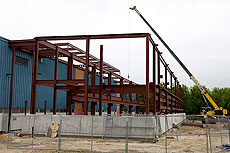Work-in-progress: IB-3 addition shaping up
 |
| Workers have set in place the steel shell for the Industrial Building 3 addition. |
When walking around the construction site of the Industrial Building 3 Addition, you need only a little imagination to visualize halls, offices, an elevator and skylights. The steel shell for the addition is now in place, marking the future location of Fermilab's new materials laboratory space.
The American Recovery and Reinvestment Act is providing $4.9 million for the project, including approximately $3 million to cover initial construction costs. The remaining budget will fund furnishings and several building upgrades, as well as construction management and a budgeted reserve to account for unplanned costs.
A. J. Maggio Co., a firm based in Mt. Prospect, Ill., received the contract to construct the addition. The project has sustained seven full-time employees, an increasingly unusual opportunity during the difficult economic times.
"Fermilab has been easy to work with and very accommodating," said Ken Kleiner, on-site supervisor for A.J. Maggio Co.
The 40-by-192-foot addition will include much-needed space for testing superconducting materials for high-field magnet research and development, and contribute to superconductor radio-frequency research and development.
"Plans for this addition have been on the board since 2003. After several functional changes, it's good to finally start building," said Fermilab Project Manager Russell Alber.
Even after making design changes to accommodate the laboratory's requirements, Fermilab project management and A.J. Maggio Co. have extended the original schedule by only four days. Within a week, eight-inch concrete decking for the second floor will be set. Weather permitting, the building will have a roof by the end of the summer and should be ready for occupancy by the end of December.
"We are very pleased with how the work is proceeding," said Romesh Sood, Fermilab's project director. "When completed, the facility will provide essential and much needed research and development space for the current projects."
-- Daisy Yuhas
Read more Recovery Act articles
|